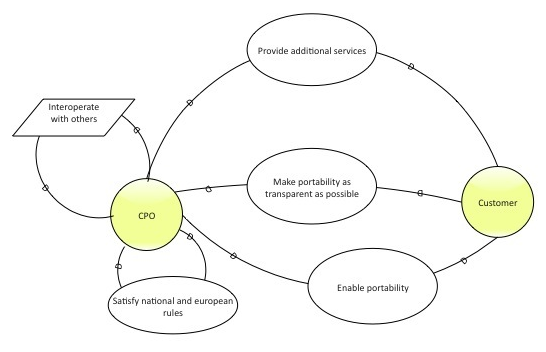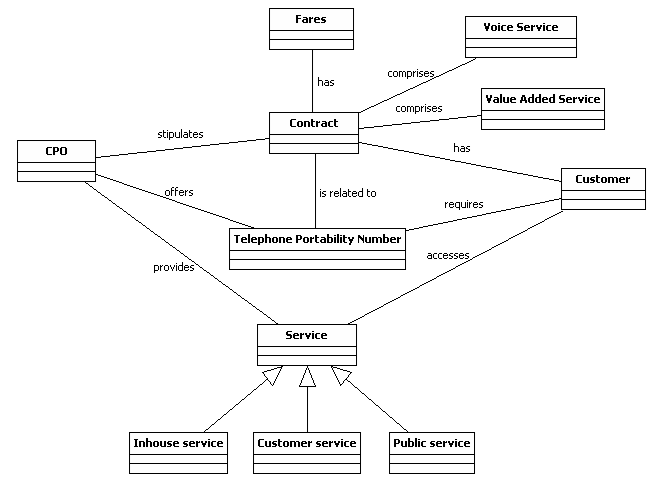Telecommunication Case Study
Contents
Description
The case study described below is about mobile phone services portability. Voice and data services are provided by a set of mobile telecommunication companies around Europe. There companies are usually called Cell Phone Operators (CPOs). Some of these CPOs operate in a single country, whereas some others are big CPOs that have branches in several countries. Inhouse services are offered by the CPO to manage all the customers and the stipulated contracts. Moreover the customers can view personal information about their contracts accessing to a suitable services made available by the telephone operator, or some user could query all the services offered by the CPO accessing its public services. Not all the CPOs have their own telecom infrastructures; some of them rent the network services from big telecom companies and provide a service to the users. Such operator are called Virtual Operators (VOs). The case study presented in this chapter is about the additional services that a company support to allow the portability of the phone number and the portability of services. The possibility to change a mobile phone operator without changing the mobile phone number is one of the mandatory services that a mobile phone operator must provide. National and European laws regulate this procedure with the aim of allowing the customers to freely select the best company according to their requirements to be advantaged by the more suitable or cheapest services offered by the new phone operator, without advising his contacts of a new telephone number. It might also happen that the portability is only about the services on which a customer is subscribed. For instance, a customer might move from an European Country to another for a limited period, e.g., one year, but keeping his subscription, even with a new phone number, with the company and using the same services already available but not by roaming. At the end of such period, the customer could move back to his home country again, picking up his original telephone number and subscription. Starting from this description of the case study, we could identify the following stakeholders:
- Cell Phone Operators (CPOs)
- Customers
Business Goals and Domain Assumptions
Business Goals and the Domain Assumptions define the functionalities and the properties of both the machines and the environment where the systems operate. Whereas the business goals state the functionalities of the product, the domain assumptions report properties or restrictions of the system.
Business Goals
| Field | Description |
|---|---|
| UniqueID | TELCO-BG1 |
| Short Name | To provide mobile phone number portability |
| Type | Business Goals. |
| Description | The system shall offer some capabilities to permit the portability of a mobile phone number across different
CPOs. Service portability makes possible to the customers change the telephone operator keeping their old phone numbers. The customer could decide to move to a certain CPO, since the charges it has for a particular service are more convenient for him. The customer would avoid to have a new telephone number, since he should have to notify all his contacts of the changed number. |
| Rationale | Satisfy the need of a customer that want to take advantage of the services of a certain CPO without change his old
telephone number. |
| Involved Stakeholders | CPOs and customer |
| Conflicts | None |
| Supporting Material | |
| Priority of accomplishment | Must have. |
| Field | Description |
|---|---|
| UniqueID | TELCO-BG2 |
| Short Name | To provide mobile phone number portability |
| Type | Business Goals. |
| Description | The system shall enable a customer moved to another country to use the service already subscribed in the former
country. Maybe not all services are available, but services could be composed by existing ones or even, if no other options are available, the customer could be linked to his home country for this service (with an extra-fee). |
| Rationale | Satisfy the need of a customer that want to take advantage of the services of a certain CPO when moving in the countries where CPO operates. |
| Involved Stakeholders | CPOs and customer |
| Conflicts | None |
| Supporting Material | |
| Priority of accomplishment | Must have. |
| Field | Description |
|---|---|
| UniqueID | TELCO-BG3 |
| Short Name | To satisfy national and european rules
|
| Type | Business Goals. |
| Description | European and National governments strictly regulate some of the services provided by the CPO. As a consequence, several regulations had been approved especially for making the change of a mobile operator as simple and economic as possible. Since these rules change during the time, the system should be able to promptly react. |
| Rationale | Enable a quick reaction in case of new European and National regulations.
|
| Involved Stakeholders | CPO |
| Conflicts | None |
| Supporting Material | |
| Priority of accomplishment | Must have. |
| Field | Description |
|---|---|
| UniqueID | TELCO-BG4 |
| Short Name | To make the portability as much transparent as possible to the customer |
| Type | Business Goals. |
| Description | To improve the customer satisfaction the portability of services and numbers should be transparent to the user. As a consequence, the user can interact either directly to the system by a Web application or supported by a company employee to apply for the number portability. The customer
should realize that the number portability occurred only at the end of the process. Only in case of problems, the customer will be contacted. |
| Rationale | To improve the customer satisfaction |
| Involved Stakeholders | CPOs and customer |
| Conflicts | None |
| Supporting Material | |
| Priority of accomplishment | Should have. |
| Field | Description |
|---|---|
| UniqueID | TELCO-BG5 |
| Short Name | To provide new added-valuee services |
| Type | Business Goals. |
| Description | The system shall enable CPOs to easily provide new services. Mainly regarding on the evolution of the Web and the spread of new application under the 2.0 umbrella, CPOs need to increase the number of services by considering all the users that consume this kind of applications. |
| Rationale | Increase the market rate. |
| Involved Stakeholders | CPOs and customer |
| Conflicts | None |
| Supporting Material | |
| Priority of accomplishment | Should have. |
Domain Assumptions
| Field | Description |
|---|---|
| UniqueID | TELCO-S-DA1 |
| Short Name | Distributed companies |
| Type | Domain assumption |
| Description | The CPO consists of multiple departments, possibly spread over multiple nations. In-house Services are shared among departments: e.g., CRM, Billing, and so on. |
| Rationale | |
| Involved Stakeholders | CPO |
| Conflicts | None |
| Supporting Material | |
| Priority of accomplishment | Must have. |
| Field | Description |
|---|---|
| UniqueID | TELCO-S-DA2 |
| Short Name | Service provisioning |
| Type | Domain assumption |
| Description | The system shall provide some useful services the customer could access. After an authentication phase the customer should access to personal data and get information about the contracts, the billing and so on. He could decide to change his contract choosing a more suitable telephone charges, or he could have a service to pay the billings. |
| Rationale | Make available services to the customers. |
| Involved Stakeholders | CPO and customers |
| Conflicts | None |
| Supporting Material | |
| Priority of accomplishment | Must have. |
Domain Analysis
Strategic Dependency Model and Context Diagram
The figure below illustrates the strategic dependency diagram of the case study. The diagram puts in evidence the business goals (the ellipses in the diagram) shared among the actors (the yellow circles in the diagram) of the scenario, showing the dependencies among them. The CPOs offer their services satisfying the national and the european rules; their goal is the provisioning of services useful to the customers in order to get information about the status of their contracts and/or to change them. In particular the current case study focuses on the provisioning of the telephone number portability service; such service should be offered to the customer in a transparent way.
Figure below illustrates the context diagram of the current case study. In the context diagram, all the actors that appear in the business goals and scenarios are agents.
Domain Model
Figure below illustrates the domain model of the current case study. A UML notation is used to represent the entities and the actors involved in the case study and the relationships among them. The CPO stipulates a Contract with a Customer. A contract is characterized by the particular Fares to pay for the service usage; it could include the basic Voice Service or some additional service (Value Added Service) provided by the CPO, such as e-mail services, SMS services and so on. When a Customer requires a Telephone Number Portability of his telephone number moving from a CPO to another one, such portability is associated to a contract. Moreover, the diagram illustrates the possibility of a Customer to access to different type of Services provided by the CPO.
And I thought I was the sensible one. Thanks for setting me staright.

